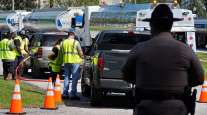Plan to Ease South Florida Cargo Congestion Back on the Table

A project aimed at helping to solve congestion at South Florida’s ports by utilizing the U.S. 27 corridor from Miami to western Palm Beach County is being revived. It proposes constructing a new railway line and expanding U.S. 27 to six lanes from four.
Michael Busha, executive director of the Treasure Coast Regional Planning Council, said that his board has directed him to move forward and meet with additional stakeholders to gauge interest in “lighting a fuse” under the project.
The project, which focuses on the approximately 75 miles from Miami to South Bay, would cost an estimated $1.25 billion. It would include widening U.S. 27 and building a rail line to handle 15 to 22 trains a day.
A new railroad path in the western regions would reduce freight traffic through the population centers of the coast between Fort Pierce and Miami, Busha said.
With Brightline’s passenger train service expected to start this summer, building a new railroad along U.S. 27 would also free up capacity on the Florida East Coast railway for passenger trains. Truck traffic could also be diverted from U.S. 27 and Interstate 95.
“On a lot of different fronts, it is a valuable piece of infrastructure,” Busha said. “It provides more capacity in the rail system, the freight system and I believe it unlocks the potential that the Glades has been looking for.”
The economically depressed communities around Lake Okeechobee would benefit, especially if an Intermodal Logistics Center is built in the region.
Busha made a presentation to the Port of Palm Beach Commission last week and said, “It’s just a piece of transportation that’s missing.”
Port commissioners have said if an intermodal logistics center, also known as an inland port, is built, they want it to be located in western Palm Beach County.
“We want to be very clear that every time we talk about this, we are interested in supporting the Glades,” Commissioner Wayne Richards said.
Commission Chairman Blair Ciklin said of the project: “I wouldn’t think there’s anyone in Palm Beach County [who] would be against it.”
In 2013, the Florida Department of Transportation released a 48-page report on U.S. 27 alternatives. The report concluded there were no fatal engineering or environmental flaws in the concept and that it was feasible.
More than a dozen routes were studied and the most feasible one identified was connecting with the Florida East Coast Railway west of Hialeah, running along U.S. 27 to South Bay, and linking to the existing South Central Florida Express/FEC tracks which run along the south side of Lake Okeechobee.
U.S. 27 connects to the Florida Turnpike, I-75 and State Road 80, and actually goes all the way to Indiana.
The project didn’t happen in 2013 due to an economic downturn and also because some of the freight haulers solved their own problems by building their own facilities, Busha said.
“It was an idea a little bit before its time, but not much,” Busha said.
Better ways are needed to get freight from Miami to the rest of the state and elsewhere. But the project won’t be cheap as it would be going through wilderness, Busha said. The railroad line would run through wetlands and the Everglades Agricultural Area as well.
The project needs to become reality before a logistics center is built, Busha said.
Busha said another meeting to discuss the project will be held within the next couple of months.
“We will also work with the South Florida Regional Planning Council and the Southwest Florida Regional Planning Council. It’s a regional project,” Busha said.
Distributed by Tribune Content Agency, LLC




